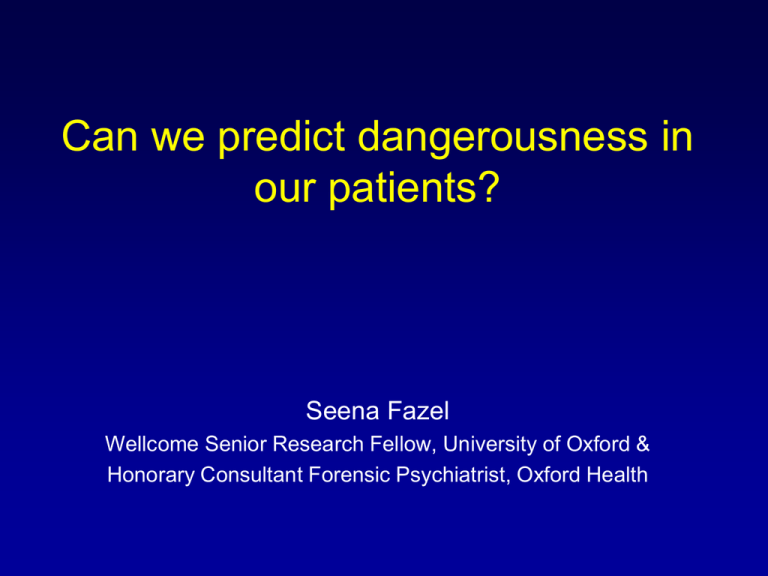Seena Fazel - University of Oxford
advertisement

Can we predict dangerousness in our patients? Seena Fazel Wellcome Senior Research Fellow, University of Oxford & Honorary Consultant Forensic Psychiatrist, Oxford Health Background and context What is the association between severe mental illness and violence? How can we predict violence in patients with severe mental illness? Public health impact of interpersonal violence Mortality and morbidity Increasing numbers of secure hospital beds and prisoners Deaths by cause, estimates for 2004 (total deaths, % total) Disability Adjusted Life Years (DALYs) Prison population England & Wales 90000 80000 70000 60000 50000 40000 30000 20000 10000 0 1990 2005 Reinstitutionalization Priebe, 2008 Khiroya, 2009 Cost of mental health services in 2009/10 Figure 2b - Risk estimates with substance abuse comorbidity Figure 6a – Risk estimates for violence in men with schizophrenia comorbid with substance abuse compared with risk in men with substance abuse (without psychosis) reported in the same study The problem of risk assessment Current approaches are expensive, resource-intensive, and not scalable Risk assessment has mixed evidence for predictive ability Guru-like system of occasional training 120+ structured instruments National Confidential Inquiry datahomicides by psychiatric patients Risk assessment tools – research questions How do these measures compare with other medical technologies? Is there an authorship effect? Which are the best ones? Are they more useful for some people than others? Does their predictive validity change using different study designs? Design-related biases? Lijmer, JAMA 1999 Authorship effects? Bekelman, JAMA 2003 New review and meta-analysis 81 samples involving 26,426 individuals Replication studies from 1 January 1995 to 1 January 2011 Diagnostic odds ratio (DOR), sensitivity, specificity, area under the curve (AUC), positive predictive value (PPV), negative predictive value (NPV), and the number needed to detain (NND) to prevent one offence were calculated Other prognostic tools AUCs from cardiovascular prognostic tools similar: Framingham 0.57-0.86, SCORE 0.65-0.85, QRISK 0.76-0.79 DORs for diagnostic tests considerably higher Summary Violent risk prediction cannot be done accurately Cannot be used as sole determinants of sentencing, release or discharge Violence risk assessment instruments have moderate PPVs, higher NPVs Implications Screen out those at low risk Mixture of clinical judgement and evidence-based clinical prediction rules Risk management We cannot predict on individual patient basis











